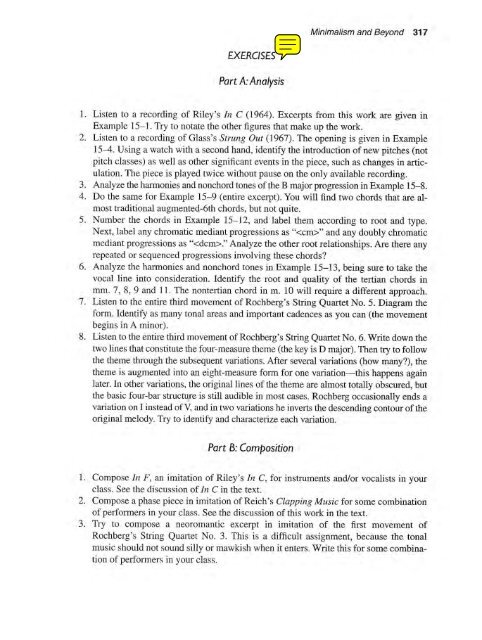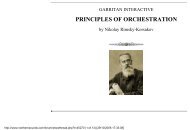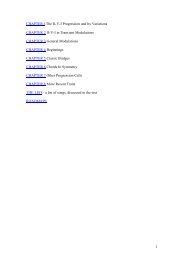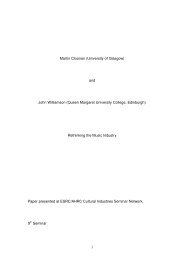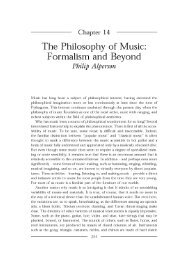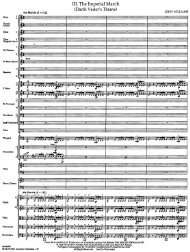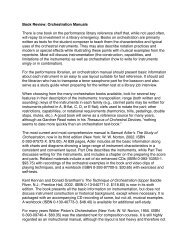TWENTIETH- - Synapse Music
TWENTIETH- - Synapse Music
TWENTIETH- - Synapse Music
Create successful ePaper yourself
Turn your PDF publications into a flip-book with our unique Google optimized e-Paper software.
EXERCISES<br />
Part A: Analysis<br />
Minimalism and Beyond 317<br />
1. Listen to a recording of Riley's In C (1964). Excerpts from this work are given in<br />
Example 15- 1. Try to notate the other figures that make up the work.<br />
2. Li sten to a recording of Glass's Strung Qut (1967). The opening is given in Example<br />
15-4. Using a watch with a second hand, identify the introduction of new pitches (not<br />
pitch classes) as well as other significant events in the piece, such as changes in articulation.<br />
The piece is played twice without pause on the only available recording.<br />
3. Analyze the harmonies and nonchord tones of the B major progression in Example 15-8.<br />
4. Do the same for Exarople 15-9 (entire excerpt). You will find two chords that are almost<br />
traditional augmented-6th chords, but not quite.<br />
5. Number the chords in Exarople 15- 12, and label them according to root and type.<br />
Next, label any chromatic mediant progressions as "" and any doubly chromatic<br />
mediant progressions as "." Analyze the other root relationships. Are there any<br />
repeated or sequenced progressions involving these chords?<br />
6. Analyze the harmonies and nonchord tones in Example 15-13, being sure to take the<br />
vocal li ne into consideration. Identify the root and quality of the tertian chords in<br />
mm. 7, 8, 9 and I I. The non tertian chord in m. 10 will require a different approach.<br />
7. Listen to the entire third movemcnt of Rochberg's String Quartet NO.5. Diagram the<br />
form. Identify as many tonal areas and important cadences as you can (the movement<br />
begins in A mi nor).<br />
8. Listen to the entire third movement of Rochberg's String Quartet No.6. Write down the<br />
two lines that constitute the four-measure theme (the key is D major). Then try to follow<br />
the theme through the subsequent variations. After several variations (how many?), the<br />
theme is augmented into an eight-measure form for one variation- this happens again<br />
later. In other variations, the original lines of the theme are almost totally obscured, but<br />
the basic four-bar structure is still audible in most cases. Rochberg occasionally ends a<br />
variation on T instead of V, and in two variations he inverts the descending contour of the<br />
original melody. Try to identify and characterize each variation.<br />
Part B: Composition<br />
1. Compose In F, an imitation of Riley's In C, for instruments and/or vocalists in your<br />
class. See the discussion of / 11 C in the text.<br />
2. Compose a phase piece in imitation of Reich's Clapping <strong>Music</strong> for some combination<br />
of performers in your class. See the discussion of this work in the text.<br />
3. Try to compose a neoromantic excerpt in imitation of the first movement of<br />
Rochberg's String Quartet No.3. This is a difficult assignment, because the tonal<br />
music should not sound silly or mawkish when it enters. Write this for some combination<br />
of performers in your class.


